Treatment
DENTAL FILLINGS
-
Dental Filling is a treatment modality to restore missing tooth structure which could have been a result of decay or trauma.
Read More...

Decay makes tooth hollow. Dental Filling helps to fill this gapprotect it from further decay. A filling is also used to repair broken or cracked tooth and the teeth which wear off due to dental habits like teeth grinding, nail biting etc.
PAINLESS ROOT CANAL TREATMENT
-
The outer portion or Crown of a tooth is a three-layered structure namely – Enamel, Dentin & Pulp.
Read More...
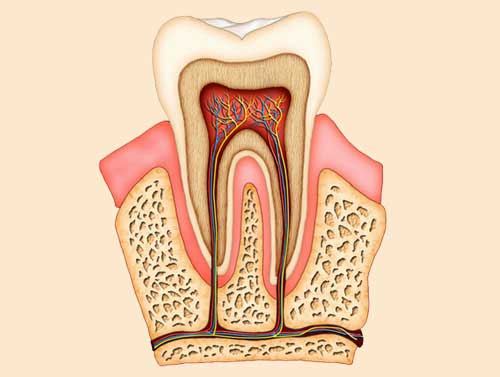
WHY DOES ONE NEED TO UNDERGO ROOT CANAL TREATMENT
WHAT ARE THE CONSEQUENCES OF NOT GETTING A ROOT CANAL TREATMENT
WHAT IS THE PROCEDURE FOR ROOT CANAL TREATMENT
POST-TREATMENT CARE FOR ROOT CANAL TREATMENT
WISDOM TEETH REMOVAL
-
Wisdom teeth often known as third molars are the last teeth to erupt. One usually gets them in late teens or early twenties.
Read More...

WHAT PROBLEMS CAN A WISDOM TOOTH CAUSE
IS THERE A NEED TO REMOVE WISDOM TEETH
SYMPTOMS TO GET WISDOM TEETH REMOVED
SHOULD WISDOM TEETH BE REMOVED
PROCEDURE FOR WISDOM TOOTH EXTRACTION
Post Wisdom Tooth Removal
PRICE OF TOOTH EXTRACTION
BRACES & ALIGNER
-
Dental braces are appliances which are used to align or straighten the teeth and guide the teeth to the corrected position.
Read More...
BRACES & ALIGNER
. They are made up of wires, brackets, and bands. Braces aid to correct irregular teeth positioning, jaw correction, improvement in chewing and smile aesthetics. Your dentist is the best person to guide on treatment options and modalities depending upon dentition.
WHAT ARE BRACES USED FOR
The major reason for getting Braces on is to improve the facial appearance, what people do not know is that there are any other implications which require orthodontic treatment like open bite, jaw structure, crossbite etc.WHAT IS ADULT DENTITION
This is a stage where adult teeth or permanent teeth replace primary teeth which aid in appearance, speech, and digestion. During this phase, people can face many issues which can be corrected by Braces. These issues include: Crowding / Haphazardly placed teeth can lead to poor oral hygiene and can also be the reason for Dental Caries (Cavities) Improper Bite that affects chewing efficiency Crooked teeth which can be a major reason for Periodontal problems such as Bleeding Gums, Halitosis (Bad Breath) and Tooth Mobility (Premature loss of teeth) If the teeth are irregular, then it can cause calculus deposits leading to yellow teeth Forwardly placed / Proclined Teeth which leads to more convex profile and posteriorly displaced chin Open Bite The spacing between teeth which can cause speech problemsWHAT IS MIXED DENTITION
This is a stage when one has a combination of both primary and permanent teeth in the mouth is called Mixed Dentition. Wearing Braces in this stage cure the following problems: Jaw Growth disorders at this stage can be corrected in a non-invasive manner which may later require surgical correction Treatment of crooked teeth. This needs to be treated during an early stage else it will affect Child’s psychologyWHAT IS THE RIGHT TIME TO GET BRACES
Every individual is different. Orthodontic treatment can be started as young as 7 years old. There is no upper limit in terms of age for Braces. If you have good oral health and firm teeth, you can get braces at any age. There is various kind of Orthodontic treatment available for all ages.WHAT TYPES OF BRACES ARE AVAILABLE
Metal Conventional Braces:
These are the traditional and most common type of braces. The metal braces used today are much more comfortable and smaller in size. These require elastics which come in a variety of colors to tie the wire to the braces. The wires use your body heat to move teeth more quickly and less painfully. There is no age limit attached to these, as patients of all ages can choose to straighten their teeth using metal braces.Metal Self Ligating Braces:
These are metal Brackets with a shutter or lock system and do not require the use of elastic to tie the wire. In comparison to traditional metal braces, metal self-ligating braces are more comfortable and smaller in size. These are helpful in achieving arch expansion and minimize the need for extraction.Ceramic Conventional Braces
Ceramic braces are the ones with clear brackets. They use tooth color and blends more naturally with your teeth. The shape and size are the same as metal braces. These are less visible on the teeth and as a result, are preferred by older teenagers and adults who might have aesthetic concerns. Sometimes, even the wires used are of tooth color which makes them less noticeable. Being less prominent, they require more care and protection compared to metal braces as they are larger and more brittle. They require extra protection, hence, are used more in upper teeth than lower.Lingual Braces
Lingual Braces are heavy metal braces which are placed behind the teeth. These metallic braces can be made even of silver or gold. The individual Bracket is customized using CAD-CAM / 3D Designing. The treatment is highly aesthetic and less visible. This, however, can cause mild speech difficulties during the course of the treatment.Aligners
Clear Aligners are medical grade plastic trays that do not require any braces or wire. They are totally invisible hence; the aesthetic concerns are duly met and make them very appealing with adults who need orthodontic treatment. Though placed inside they do not have any food restrictions associated. People believe that being placed on the inside, they might face speech difficulties; which is a myth. On the other hand, transparent braces are highly comfortable and hygienic. Clear Aligners also hide existing gaps.COST OF BRACES AND ALIGNERS
The cost of braces and aligners completely depends from person to person depending on the teeth alignment & multiple other factors. There is no standardisation of charges for braces and aligner treatment. At that first appointment, the dentist will examine you and take a digital scan of your cavity among other things. He or she will be able to offer you an exact estimate of the cost of the braces and aligners along with the duration of treatment based on this information.POST TREATMENT CARE FOR BRACES
Brush & Floss twice a day to keep your teeth healthy. Healthy teeth respond better to the treatment. Visit your dentist on time for follow-up checks. Make a note of your appointments and follow suggestions, if any. Be patient. The treatment duration may vary depending on the case. The teeth will take the time to adjust accordingly.DO’S AND DON’TS WITH BRACES ON
DO'S
DON'TS
CLEAR ALIGNER
-
Clear Aligners are transparent trays made of special material which are used to straighten teeth just like braces
Read More...
CLEAR ALIGNER
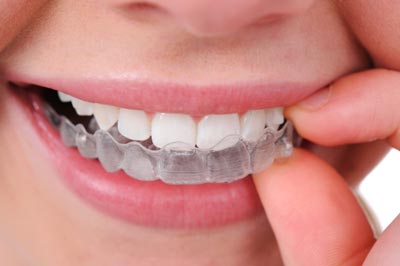
They use gentle and constant force to move the teeth in the required position without going through the hassles of metal wires and brackets. They are custom made for each patient through a digital scan.
HOW DO THEY WORK
They are custom made for every person and designed to move teeth in the desired direction very very slowly. This is achieved by digitally capturing impression and processing the information using specialized software, where the future projections for better results and straighter teeth are computed and then the milling machine automatically custom fabricates the set of trays for you. On average, a person needs approximately 25-40 sets for complete alignment. The aligners come with an advantage i.e. they are very snugly fitting which over a period becomes virtually a part of the body and hence causes no speech problems. There are no restrictions on eating and drinking any foods as you will be removing them before every meal.DIFFERENCE BETWEEN TRADITIONAL BRACES & CLEAR ALIGNERS
|
Traditional Braces |
Clear Aligners |
|
|
Visibility |
Highly Noticeable |
Invisible – One cannot spot them easily |
|
Removability |
Non – Removable |
Removable – People have freedom to remove aligners while eating, brushing & flossing |
|
Oral Hygiene |
Difficult to maintain routine healthy Oral Care |
Since removable, it is easy to maintain routine healthy Oral Care |
|
Comfort |
Can cause abrasion in mouth |
Fits smoothly on the teeth |
|
Duration |
Takes longer than aligners(varies from case to case) |
Takes relatively less time than traditional braces(varies from case to case) |
CARE WITH ALIGNERS ON
Though aligners are the most comfortable option, yet there are certain things that need to be kept in mind while you have it on. Your Orthodontist will give you a set of guidelines that should be followed diligently such as below:POST-TREATMENT CARE
COST OF CLEAR ALIGNERS IN INDIA
The cost of Invisible Braces Treatment or Clear Aligner Treatment varies depending on the alignment of teeth and other factors that can be assessed by a dentist with a full mouth scan. The cost of treatment is determined by a variety of criteria, including the intricacy of the case, the number of improvements required, and the number of aligners used. While all of these factors are interconnected, the number of aligners required for treatment is one of the most important.ADVANCED GUM TREATMENT
-
Gum disease is an inflammation of the gum line that can progress to affect the bone that surrounds and supports your teeth.
Read More...
ADVANCED GUM TREATMENT

Gum Disease also known as Periodontal Disease begins with bacterial growth in the mouth, the localized inflammation of the gingiva is initiated by bacteria in the dental plaque, which is a microbial biofilm that forms on the teeth and gingiva. Nearly 70% of the people are affected by this disease at some point in their life. Though such a prevalent disease most people are unaware of the issue and the problems it can cause.
CAUSES OF GUM DISEASE
The primary cause of Gum Disease is poor oral hygiene. If you are not brushing or flossing properly, then the chances of bacteria build-up are high. However, there are other reasons as well such as:
SYMPTOMS OF GUM DISEASES
STAGES OR TYPES OF GUM DISEASE
The stages of Gum Diseases are as follows:GINGIVITIS
This is the first stage of gum disease, caused due to the plaque build-up on gums. If the plaque is not gone after brushing and flossing, then it can cause irritation. In this stage, you will notice your gums bleeding while brushing and flossing. Because bone is not affected in this stage, the chances of recovery are quite high.PERIODONTITIS
Gingivitis if not treated on time, can lead to Periodontitis. This stage starts affecting your bone. Spaces are formed between bone and gum line as a result, bacteria will get a space food lodgement. If you visit your dentist on time then Periodontitis can be prevented. Periodontitis is an advanced gum disease.ADVANCED PERIODONTITIS
This is the final stage of your gum disease where your bone is destroyed making your teeth loosen further. This can only be saved with surgery. And if the case is very advanced then even surgery cannot save your tooth, as a result, your dentist has to extract your tooth.TREATMENT OPTION OF GUM DISEASE
The treatment option depends on the stage of Gum Disease. It also depends on your medical history and your overall health. The treatment options range from non-surgical therapies to surgical treatments.The Non-Surgical Options Include:
Deep Cleaning
This is done in the very initial stage of developing a Gum Disease. Your dentist will remove the plaque or tartar (which hardens the tooth surface) from below and above the gum line. It is a preventive measure which helps you to save from getting gum disease.Scaling & Root Planning
This is also a deep cleaning process. The only difference is that your dentist will give local anesthesia to start the process. Plaque and tartar are removed from above and below the gum line and after that, the rough spots are made smooth. The process of smoothing helps to remove the bacteria. This is done only if your dentist finds that you have calculus deposits under the gum.Surgical Treatment Includes:
Flap Surgery
In this, incision is made on the gums to remove the tartar. Sometimes the irregular surface of the bone is smoothened so that there are no areas for bacteria which cause this disease can hide. This method is used to remove the gap between gums and tooth.Bone Graft
This method is used to regenerate the bone. The dentist use fragments of synthetic bone donated bone or your own bone which is used to replace the bone destroyed due to gum diseaseSoft Tissue Graft
This method is used if the gums are receded. Gums are taken from the roof of the mouth and is stitched to the area of gum recession.Guided Tissue Regeneration
Done along flap surgery when bone which supports your teeth are destroyed. Your dentist will insert a small piece of mesh-like fabric between your bone and gum tissue.PREVENTION OF GUM DISEASE
PRICE FOR GUM DISEASE TREATMENT
The progression and the location of gum disease are the main factors responsible for the difference in price for its treatment. Delaying gum problems not only affects oral health as a whole, it directly impacts overall health for instance, its directly related to increased risk of heart disease. At Clove Dental, in India, gum diseases are cured at competitive prices.TMJ PROBLEMS
Temporomandibular dysfunction or TMJ is a condition in which a patient feels pain and discomfort around the face and jaw area. This condition is caused by muscles problem that affects the jaw movement of a person. A specialised orthodontist can help a person in great extent in such scenario. There is much treatment that can be beneficial for the patient:Consumption of soft food:
Chewing of hard food puts extra pressure on the jaw, so it’s recommended to eat soft foods such as mashed potato, yoghurt, cottage cheese and soups, where you don’t have to put a lot of chewing effort. Ice packs/ moist heat/exercise- applying moist heat helps in lose the tension from tight muscles and can prevent spasms. Apart from that, your doctor will recommend you some face exercises that can be beneficial if you follow it regularly.Medicine:
Your orthodontist may recommend you Nonsteroidal Anti-inflammatory drugs to relieve the pain and swelling of your muscles. A muscle relaxant can aid in loosening the tight jaw muscles, providing relief from the pain during grinding or clenching the teeth. To control the pain, orthodontists may also prescribe you antidepressants in a very lower dose.Splints:
This is a piece of equipment that can be used by patients who are facing TMJ issues. It prevents the touching of lower and upper teeth, preventing you to grind and clenching your teeth.DENTAL IMPLANTS
-
Dental implants are easily the most popular and also the ideal solution, for replacing your missing tooth/teeth
Read More...
DENTAL IMPLANTS
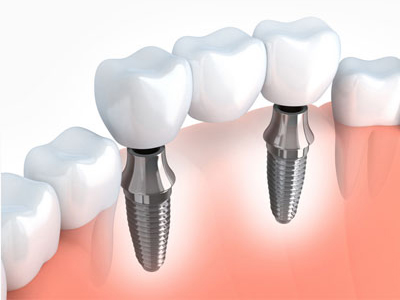
They have definitely changed the course of dentistry in the last quarter of a century or so. A dental implant is basically a titanium post which is surgically inserted into the jawbone beneath the gum line to work as a tooth root. Post insertion, an implantologist will attach a crown on top of the implant to ensure the appearance of a natural tooth. Tooth Implants not only look and feel like your natural teeth but also function like.
WHY DENTAL IMPLANTS
One can face the problem of missing teeth at any point in life. Tooth loss can be due to trauma, accident, severe gum disease, tooth decay or even due to poor oral hygiene. If left untreated missing teeth can lead to various consequences such as:Dental Implants help to overcome all the above-mentioned problems. They are no doubt the best, and most popular solution for the replacement of missing teeth. Dental implants are fit for every individual having missing teeth irrespective of their age and gender. To know if anyone can get dental implants click here. With a 98% success rate, implants assure dental patients about their teeth and gum’s wellbeing. Dental Implants are essentially a ‘titanium screw’ which is fused with the Jaw Bone.
Difference Between Dental Implants & Bridges
|
Bridges |
Implants |
|
May compromise the adjacent natural tooth |
Does not compromise with an adjacent tooth |
|
A bridge may need replacement at times where bone loss continues at the site of the missing tooth |
An implant causes no bone loss as it gets attached with the bone and promotes healthy bone |
|
With bridges, your teeth may be prone to plaque, decay or gum disease, with a risk of possible future root canal |
With no free spaces in between, implants won’t attract bacteria ever for plaque accumulation |
ADVANTAGES OF DENTAL IMPLANTS
DENTAL IMPLANT PROCEDURE
Placing a dental implant has various stages. They are listed as below:Placing The Implant
Thanks to the modern dentistry techniques, it’s possible to make the implant placement procedure comfortable and pain-free. Concerned patients can also ask the dentist for sedation to feel relaxed while a dental implant is placed.The procedure starts with the jawbone preparation, and the surgeon then makes a cut to expose the bone for drilling holes. The holes are kept deep enough for the implant to be placed properly and placed deep into the bone, like the root.
The doctor may require bone grafting in cases where the bone is weak or lacks the strength to support implant surgery. The surgeon then waits for the jawbone to heal and after that, places the metal post in it.
The entire process, from start to finish, may take many months where most of the time is spent on healing and waiting for the growth of new bone in the jaw.
After this, a temporary crown is given to the patient which is placed to fill the gap, and also for achieving the aesthetic goal. This crown can be taken off for implant procedure, one has to wait until the bone is healed properly
Healing
During this process, the jawbone will grow and unite with the surface of the dental implant. This process is also referred to as osseointegration as it helps to offer a durable base for the new artificial tooth, much like roots do for the natural teeth.In general, this process takes between 3 to 6 months depending on the bone health & structure. However, the whole procedure can get completed in one day itself when patients have good bone structure.
After that, you can schedule the second surgery but only once the implants are fused with the bone. Your dentists will take an x-ray to confirm whether the implant is fit for the second surgery.
The second surgery will be simpler than the first where a new incision is made to expose the heads of the implants.
Abutment Placement
You may need another surgery to place the abutment (the piece where the crown will attach) but only after healing is complete. This procedure is relatively simple typically done with anesthesia in an outpatient setting.During the procedure, the dentist will re-open the wound to attach the abutment to dental implant. A temporary crown will be given for 4 to 6 weeks to let the gums around the abutment heal. Such a crown is softer which can cushion the implant and may stress the soft tissues that can help in healing.
For precaution purpose, you may need to eat only soft foods after each stage of surgery so to let the surgical site heal properly.
Placement Of Permanent Crown
In the next stage, the dentist will focus on making the permanent crown look exactly like your natural teeth. All the elements like the surface texture, color and anatomy will be tuned up to blend with the surrounding dentition.If you are not happy with the crown for any reason, consult your dentist so that it can be sent back to the dental technician for necessary changes.
Impressions of your mouth and remaining teeth are taken to make the crown so that a realistic-looking artificial tooth can be made. The crown, however, will not be placed until the jawbone is strong enough to support the new tooth.
It takes less than 2 to 3 weeks to make a permanent crown which will then be cemented or screwed to the Implant.
After permanent crown placement, your doctor will explain post-implant care instruction.
POST-OPERATIVE INSTRUCTIONS FOR DENTAL IMPLANTS
DENTAL IMPLANT COST
The cost of dental implants may worry some patients; however, implants are not too heavy on your pocket. There are multiple parts to each procedure which actually leads to a perception of implants being expensive. It is critical to understand that if a missing tooth is not replaced with an implant, sooner or later the adjacent teeth start shifting and jawbone loss also starts which ultimately would turn out to be much more expensive to manage than a single dental implant.POST IMPLANTS CARE
Good oral hygiene is important not just for your teeth and gums but also for overall wellbeing. Follow these tips to improve your oral health:Visit the dental clinic regularly and try to achieve good oral hygiene to make your implants last for life.
DENTURES
-
Dentures are removable appliances which are used as a replacement of missing teeth and tissues.
Read More...
DENTURES
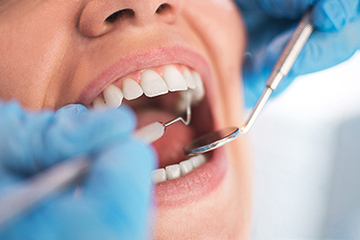
. They are the artificial teeth which enable normal functioning of human mouth. Dentures are of two types – Complete & Partial.
Complete dentures are advised when all the teeth are missing, and partial dentures are applied when some natural teeth are missing. They are custom made especially for a set of teeth and gum line.
Complete Dentures fit over the upper teeth and roof and on the lower teeth placed like a horseshoe. They are conventional dentures and are removed during the night for cleaning.
Partial Dentures consists of replaced missing teeth attached to artificial gum connected by a metal framework which helps to hold the denture in place. Missing teeth can change the position of other teeth hence partial denture help to overcome this problem and keep the teeth intact.
TYPES OF DENTURES
Dentures are made of porcelain and acrylic resin.
Porcelain dentures look more natural and match easily with the remaining teeth. But porcelain, if dropped, will break easily and can wear down the remaining teeth hence, are better used as complete dentures rather than partial.
Acrylic resin dentures, on the other hand, are light in weight and easy to adjust. They fit properly and make the jaw movement smoother.
WHAT IS THE PROCEDURE INVOLVED IN PLACING DENTURES
Step 1 The doctor will first take the impressions of your jaw to analyze how well they relate to one another and whether they have spaces in between them.Step 2 A wax model is then prepared to check the fitting.
Step 3 Final Denture is made with the wax model.
Step 4 The patient is made to try the final set of dentures and if necessary adjustments will be made.
HOW TO TAKE CARE OF THE DENTURES
Since these are artificial and removable, therefore, it becomes extremely important to handle them with care. If you want your dentures to have a longer life, the following tips should be taken into consideration:
Keep Your Dentures Clean
Always ensure that your dentures are clean for this you need to brush your dentures with a non-abrasive brush at least once a day. Though they are artificial, yet plaque and bacteria can build up on the teeth causing damage to other teeth and gums. If possible remove your dentures after every meal and wash it with warm water but if you have complete dentures, then mere brushing would do.
Overnight Protection
Soak your dentures at night in water or in the denture solution as prescribed by your dentist. So that your dentures do not weaken avoid chlorine with it. While putting dentures on in the morning make sure you rinse them with clean water as this will help to remove the chemicals if any during the soaking process.
Keep A Look At Your Dentures
Monitor your dentures time to time and visit your dentist if your dentures loosen, slip or you come across a change in the bite. Having ill-fitting dentures can cause infections and irritations.DO’S AND DON’TS WHILE DENTURES ON
DO’S
DON’TS
MYTHS ABOUT DENTURES
COST OF PARTIAL DENTURES
The cost of partial dentures varies depending on a variety of factors, including the materials used, the number of teeth replaced, and the process of making the dentures. You may also require dental treatment prior to partial dentures. In such cases, the cost may marginally increase.
PREVENTIVE DENTISTRY
-
The practice of looking after your gums and teeth and maintaining good oral hygiene to keep them healthy is known as preventive dentistry. Read More...
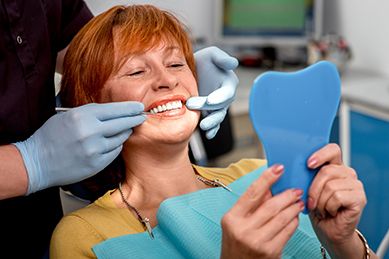
PREVENTION OF DENTAL DECAYS
PREVENTION OF GUM DISEASES
PREVENTION OF CROWDING OF TEETH
ADVANTAGES OF PREVENTIVE DENTISTRY
WHO ALL ARE BENEFITTED FROM PREVENTIVE DENTISTRY
Preventive Dentistry is for all. Starting right from childhood when the teeth are just emerging to the stage when one might have a chance of losing their teeth or have lost some. In kids, they help in preventing the teeth from getting decayed and also helps your newly grown permanent teeth to stay strong and fit. In growing adults, this keeps the permanent teeth healthy which eventually can be a reason for healthy living. Because Oral Health is a window to your overall health, therefore, keeping your teeth protected ensures healthy living and more years to your age.Best Practices For Healthy Teeth
WHY SHOULD I PAY FOR PREVENTIVE DENTISTRY MEASURES
Preventive dental visits help in early management of budding dental problems which is much less expensive as compared to addressing these problems when they have become worse & need more aggressive management & correspondingly higher expenses. The cost depends on several factors especially treatments opted for and your oral condition. You can learn more about them in detail by visiting any of our dental clinics in India.BRIDGES &CROWNS
-
Dental Crowns are a tooth-shaped cap which is placed on the tooth to restore the shape, size, and appearance of the tooth.
Read More...
BRIDGES &CROWNS
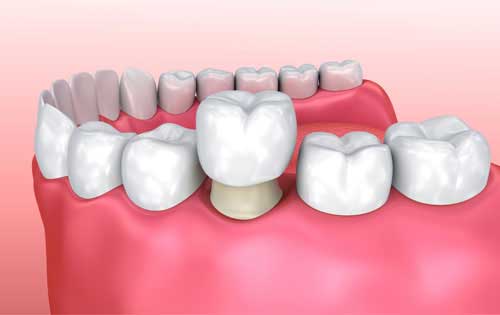
It also enhances the strength of the tooth. If the major part of the tooth is missing, then the crown is the best solution for it. By placing the crown, a tooth can function normally again.
WHEN IS DENTAL CROWN NEEDED
Dental crowns are used as caps on missing or fractured tooth to protect the life of your teeth. Dental Crowns are needed to:
In addition, Dental Crown gives your tooth the strength, shape, size and help to improve the appearance of your tooth. If your dentist has advised, you to get a crown and you are delaying the process then there are chances that you can damage your tooth to the extent that extraction is the last resort.
Moreover, not getting a dental crown can wear down other adjacent teeth causing damage.
WHAT ARE THE PRECAUTIONS TO BE TAKEN
Dental Crowns can be made in variety come in various materials such as:
Metal Crowns
If someone is looking for long term and the durable solution then metal crowns are to the rescue. The gold crowns in these are the most used and bonds well with the tooth. These can even withstand hard chewing forces and biting. Being stronger they last longer and do not wear down easily. The only drawback is that they are visible from a distance hence, suitable only for molars.
Porcelain-Fused-To-Metal
If you have aesthetic concerns and also wish to have metal crowns inserted then these are the best option available. The inside of the teeth is made up of metal and the outer portion of the crown is made of porcelain, as a result, it has the dual advantage – metal which provides strength and porcelain which matches with the color of the teeth making it look like natural teeth. They look the most like natural teeth.
Ceramic Crown
If you do not want to have metal inserted inside your mouth but want the strength to match metal crowns then ceramic crowns are the best option available. Not only is the strong but blends more naturally with your tooth color making it unnoticed. It does not have any aesthetic concerns and is the best option for the front, back and even for the bridges. The problem of porcelain wearing down and metal being visible is solved by this Dental Crown. They may not be considered as an option for molars because forces applied while biting can wear down your teeth.
DO’S AND DON’TS WITH DENTAL CROWNS
DO’S
DON’TS
MYTHS ABOUT DENTAL CROWNS
Dental Crowns carry a lot of myths with them a few of them are:
Dental Crowns Do Not Look Natural
There is a misconception that dental crowns do not match with your teeth hence give the impression of an artificial tooth. However, with changes in technology crowns come in various material which looks exactly like your natural teeth. And even metal crowns are a good and viable option because they are used as molars and are never seen.
Crowns Last Forever
Though the crowns are now stronger and have longevity, yet they cannot last a lifetime. It also depends as to how well they are taken care of. To ensure they last longer visit your dentist after every 6 months, your dentist will monitor your crown and will replace it timely.
Food And Beverage Stains The Crown
The biggest myth that people carry. They believe that food and beverages can stain their teeth with time but in reality, the crowns are made of porcelain and ceramic which do not stain easily.
Only Used For Restorative Dentistry
People believe that one gets crown only if they have fractured tooth, have undergone root canal treatment or have broken or chipped a tooth. But the truth is they are used in cosmetic dentistry as a way to enhance the appearance and to have a whiter and beautiful smile.Dental Crowns Do Not Break Or Chip
Though ceramic and porcelain are harder substances yet if you bite on something extremely hard, or face accident or trauma then your crown may break.You Cannot Get Cavity With Crowns
Because crown covers your tooth, therefore, they become vulnerable to decay. Though crowns, as they are artificial, have no chances of decay yet the part below them can decay. It is, therefore, required to keep your teeth and the area around clean to prevent a cavity.
HOW MUCH DO I HAVE TO PAY FOR DENTAL BRIDGES AND CROWNS?
The price of dental bridges and crowns depends on the type chosen by the patients. For example, you’ll have to pay more for an all-porcelain bridge than for a metal bridge However, it is an affordable option and patients can also choose to pay the price in EMIs at Clove Dental clinics.
INSTANT TEETH WHITENING
-
Teeth whitening is a process of removing stains from the tooth surface and restoring the natural color of the teeth.
Read More...
DENTAL FILLING
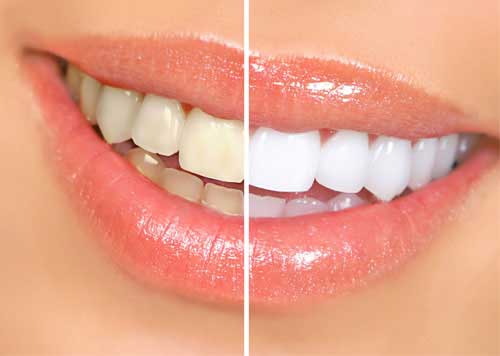
Whitening is a one-time procedure performed by a dentist. It is amongst the most common and widely adopted cosmetic procedure. With the advent of the latest Dental technology, we have advanced whitening treatment procedures which give reliable and long-lasting results.
For better results do get it done from a trained dental professional.
WHAT IS THE NEED FOR TEETH WHITENING
The enamel which reflects the natural color of your tooth can stain or dentin which is the inner surface of teeth stains and yellows the teeth. The causes of tooth discoloration are varied. Though many causes can be prevented yet there are some which are not in control. The causes of discoloration are:HOW DOES TEETH WHITENING WORKS
Your dentist will first photograph your teeth which will help to know the progress of the treatment. This is also used to examine your tooth and figure out the stains. After examining the tooth dentist will start by cleaning the tooth. He will remove the film on your enamel coated due to the food you eat or due to other substances. The whitening process begins after this. The entire process takes around 30-90 mins depending upon the severity of the stains on teeth. Your dentist will cover the gums and will then apply the whitening agent on teeth. Some whitening agents require laser lights on them and if your teeth are badly stained then your dentist will suggest you continue the process at home for a few days. You can also opt for home whitening treatment, in this, your dentist will take an impression of your teeth and will make a custom fit mouthpiece. This helps the whitening agent to stay intact on your teeth. One can also buy over the counter whitening products which is suitable only for the teeth which are not heavily stained.
IS THERE A RISK ASSOCIATED WITH TEETH WHITENING
Teeth whitening do not have any risks associated however, some people may feel sensitivity for a few days or can experience mild gum irritation for some days. Because Teeth Whitening is a cosmetic procedure it is not advised to pregnant ladies. They can get it done only after delivery. To know more about Teeth whitening click here.
COST FOR TEETH WHITENING
The cost of teeth whitening might vary greatly depending on the product and technique used. In addition, it also depends on the condition of your teeth. The dentists at Clove Dental would be able to give you an estimate after a complete evaluation of your teeth and smile.
SMILE MAKEOVER
-
Smile Makeover is a process of improving the appearance of a smile through various procedures are cosmetic or surgical. Read More...

WHAT IS SMILE MAKEOVER
Smile makeover takes into consideration the tooth color, tooth size, tooth shape, tooth position, lip position, lip length, gum position, and gum color.
Tooth Colour
Bright and white teeth are a sign of youthful appearance. The dentist will match the color of the teeth with skin tone, skin color, and hair color. He can change the color of the teeth by Bleaching or Veneers. The line from incisal edges of upper teeth from side to side should follow the contour of the lower lip for an aesthetic appearance.
Tooth Size/Shape
As the age increases the teeth become shorter due to attrition. Long teeth give a young look. Some teeth are slightly abnormal in shape as compared to adjacent teeth eg. Peg laterals which give an unaesthetic appearance. The size and shape of the teeth can be changed by veneers or crowns. The white show (tooth show) can also be increased by procedures like crown lengthening or changing the gum line (in cases of a gummy smile) by the help of laser dentistry. The width to length ratio of the upper central incisors should be 4-5 for a balanced smile line.
Tooth Position
Crooked, crowded or spacing between teeth can be corrected by using Braces, Aligners or Veneers.
Missing Teeth
Missing teeth can be replaced by using Bridges, Implants or other Removable Prosthesis.
PROCEDURES INVOLVED IN SMILE MAKEOVER
The procedures involved in smile makeover can be mix of
Veneers/Crowns
Teeth Whitening
Teeth whitening is a process of removing stains from the tooth surface and restoring the natural color of the teeth. Whitening is a one-time procedure performed by a dentist. It is amongst the most common and widely adopted cosmetic procedure.
Composite Bonding
Permanently attaching a tooth-colored material (composite) onto the tooth is called composite bonding. This can be Direct or Indirect. Direct composite bonding can be used by dentists on the chair to do fillings, repair fractured edges and close gaps. Indirect bonding is usually done in the lab.
Dental Implants
Dental Implants are root-like titanium screws which are surgically placed in the jaw bone for replacement of missing teeth. It greatly increases the self-esteem of the patient as it closely simulates the natural tooth. It does not cause any speech difficulty and has high acceptability.
Orthodontic Treatment
Orthodontic treatment is a way of straightening teeth to make them look more esthetic and improve function. The treatment can be done by Braces and Aligners (Invisible Braces). There are tooth-colored braces, metal braces, and lingual braces. The treatment usually takes 12-18 months to complete but is more stable and long lasting as it preserves the natural integrity of teeth.
WHY SHOULD ONE OPT FOR GETTING SMILE MAKEOVER
Smile Makeover is a boon in dentistry as it makes the patient look more esthetically acceptable in society. It remarkably increases the self-confidence and self-esteem in patients. It also contributes to better function helping patients to lead a more comfortable lifestyle.
WHAT ARE THE PRECAUTIONS TO BE TAKEN
POST TREATMENT CARE
Smile makeover requires regular maintenance of oral hygiene. The patient has to visit the dentist every 6 months for a checkup and any minor repairs.
SMILE MAKEOVER PRICES
Depending on your dental health, the length of treatment and cost of your smile makeover will differ. If your dentist detects any underlying oral health concerns before commencing treatment, your Delaying gum problems not only affects oral health as a whole, it directly impacts overall health for instance, its directly related to increased risk of heart disease. However, if you are someone with immaculate oral health, then the charges become significantly reasonable.
KIDS DENTISTRY
-
Humans start teething when they are as young as 6 months old and develop their set of primary ‘milk’ teeth. Read More...

At the age of 6-7 years, humans start losing their milk teeth and the permanent set of teeth start emerging. Because the milk teeth will eventually fall off, some parents tend to ignore taking their child to a dentist. However, these milk teeth form the basis of developing permanent teeth. If proper care is not taken the problems can emerge which will last a lifetime. In recent years the cases of caries in children have grown manifold. Therefore, it is always advised to start taking care of your baby’s teeth in the very early stages of their life. This includes setting Oral Hygiene routine and regular visits to pediatric dentist.
WHY DO WE NEED A KIDS SPECIALIST
Kids Dentist or Pediatric Dentist are trained to take care of dental complexities of kids and teens. Pediatric dentistry is a separate field dedicated to kids, their Oral Health prevention and preparation for the future.
WHAT TREATMENT MODALITIES ARE OFFERED BY THE PEDIATRIC DENTIST
Pediatric Dentist work towards maintaining good oral health in kids. The treatment provided by them includes:
TREATMENT OPTIONS FOR KIDS
Root Canal Treatment In Milk Teeth
If you think your child is too young to need root canal treatment, think again — there is no age limit for this treatment. If his/her primary (baby) teeth have been injured, or if decay has advanced deep into the roots of your child’s teeth, a root canal treatment to stabilize teeth may be needed. Root canal treatment removes the infection from the pulp, the living tissue that is found inside the tooth’s roots. The pulp contains the tooth’s nerves, so tooth pain is often an indication that decay has moved into the pulp. Root canal treatment is a simple procedure wherein instruments are used to clean the root canals of teeth followed by inserting a medication so as to maintain the teeth properly in the oral cavity.
Oral Habits In Children
Frequently children acquire certain habits that may either temporarily or permanently be harmful to teeth and tooth supporting structures. These habits are acquired as a result of repetition. In the initial stages, there is a conscious
effort to perform the act. Later the act becomes less conscious and if repeated often enough may enter the realms of unconsciousness. Some common oral habits seen in children include thumb sucking, mouth breathing, tongue thrusting,
lip biting, grinding of teeth and nail-biting. Certain reminding appliances called habit breaking appliances assist the child who is willing to quit the habit but is not able to do so as the habit has entered the subconscious level.
They may be removable or fixed appliances.
Common Appliances in Pediatric Dentistry:
PREVENTION TREATMENTS FOR KIDS
Fluoride Application
A common problem for which parents usually take their children to the dentist is decay. This is because there is a lack of proper dexterity of brushing in children. To avoid the problem of decay, parents should get the Fluoride application treatment in children at regular intervals. Fluoride helps to fight plaque and bacteria which can cause enamel loss which further causes cavities. Fluoride also strengthens the tooth structure & helps in bone growth. Under this treatment, the dentist incorporates fluoride ions into the tooth structure making them more prone to acid dissolution. This treatment is equally useful for both milk & permanent teeth.
Sealants
The main reason for decay is the food and bacteria that is trapped in the pits & fissures of teeth. We chew food from the back teeth like molars and premolars which are never flat. The pits & fissures as discussed above are the depressions on these back teeth. They function as potential traps for bacteria & food and make it susceptible to decay. Therefore, as a preventive measure, certain pits and fissure sealants are placed. Dental sealants then come to the rescue. Sealants are plastic coatings placed on the chewing surface of the permanent tooth. They protect the tooth from decay. Because of fissures the permanent back teeth, molars, and premolars are vulnerable to decay. As we talked about the habits, it is important to inculcate the habit of maintaining good oral health at a very initial stage. This is an investment which will pay lifelong dividends in the form of healthy teeth and a healthy lifestyle. Parents should take initiatives to teach their children the correct technique of brushing and for that, it is highly important that they themselves should know the correct way of brushing. Make brushing a fun-filled activity for your child, brush along with them and encourage them to take preventive actions.
Toothpaste And Toothbrush
Apart from the aforementioned treatment options, make sure that your kids brush twice daily. Brushing before sleeping is extremely important because the food you eat during the day get stuck between your teeth and bacteria in your mouth will feed on that food overnight causing decay. If possible teach your child how to floss as it is the added protection for your teeth
WHAT TO PAY FOR KID'S DENTISTRY SERVICES
Pediatric dental visits cost a little less than adult visits generally. For most of the services like cleaning and common checkup, the prices are affordable. However, some dental treatments can be marginally higher in cost if your child’s dental health is not immaculate. You can learn more about them in detail by visiting any of our dental clinics in India. Clove has experienced specialists for kids dental care right in your neighborhood. Ideally, it is advised that a child’s first dental visit should be planned when the first tooth erupts
MOUTH ULCER
-
Mouth Ulcers commonly known as canker sores are painful lesions in the mouth or at the base of the gums or inside cheeks or lips. In scientific terms, it is the loss of tissue lining in the mouth.
Read More...
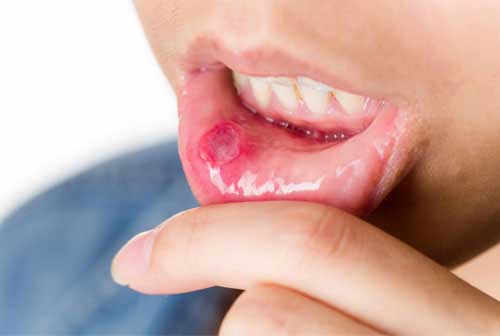
CAUSES OF MOUTH ULCERS
Women, children and the one having a family history are most prone to developing Mouth Ulcers. Though the exact cause of Mouth Ulcers could not be known several factors can attribute to the same:TREATMENT OF MOUTH ULCERS
Mouth Ulcers do not need treatment as they go away with time. But if the ulcers are large and extremely painful please visit your dentist for treatment options:HOW TO AVOID MOUTH ULCER
TYPES OF MOUTH ULCERS
The uncomfortable and painful sores can be of various types. The most common amongst these are:TREATMENT OF MOUTH ULCERS
Mouth ulcers need to be treated at their early stages so as to avoid any extra expenses that might incur later if the situation is neglected. For the best prices, you need to contact your nearest Clove Dental clinic in India.Copyright © 2021-2026 Smile Kraft Dentaire by Ciarpro Technologies